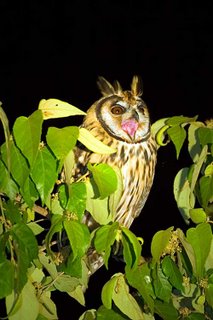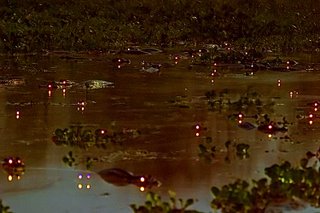A neat challenge for wildlife photographers is to get good images of nocturnal animals. Among the difficulties, I emphasize the inherent search for critters in the dark, the need to provide supplementary light in order to make the photos and the quest for a framing or background which adds creativeness to the image.
In the Pantanal, there is a popular tourism activity called “spotlighting”, in which visitors go on roads or rivers at night with strong light beams. It is by far the best way to find animals such as foxes, ocelots, owls, nightjars, caimans and many others. Besides helping on the search, the light can be useful to help on framing, focusing and lighting up the subject.
 Long-tongued bat (Phyllostomidae/Glossophaginae) making use
Long-tongued bat (Phyllostomidae/Glossophaginae) making useof a hummingbird feeder at the Atlantic Forest
PHOTO © Daniel De Granville, 2005
Speaking of light, using a flash (which I assume as a “necessary evil”) will be almost always mandatory, unless the animal is very close, the light beam is very good, your lens has a wide aperture and the ISO is at its highest settings.
A more creative image can be obtained by “playing around” with shutter speed to make use of the ambient light, or using some of the flash’s special features, or by using peculiar techniques such as “light painting”. It is important to highlight that, since these photos show critters who are less known by the general public (since they are nocturnal), this kind of photography might delight the observer more easily than a daytime shot.
Last, but just as important: the seek for animals at night must follow certain criteria to avoid excessive disturbance on them. A strong light source, used persistently during a critical period, can disturb feeding and breeding of a nocturnal animal, or make it more vulnerable to predators. If the animal has diurnal habits and is found at rest, the use of such means shall be strictly avoided.
 Striped Owl (Rhinoptynx clamator), a species that prefers
Striped Owl (Rhinoptynx clamator), a species that prefersopen areas and whose diet includes vampire bats
PHOTO © Daniel De Granville, 2006
.
.
.


No comments:
Post a Comment